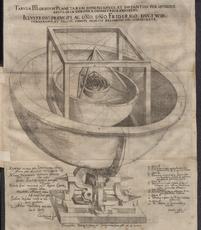The theory Einstein hated
The universe is expanding – that was finally accepted even by Albert Einstein, who had resisted it for years. ETH Zurich Professor emeritus Harry Nussbaumer and Lydia Bieri show in their new book how astronomers moved from a view of the cosmos as a sphere around the earth to the idea of the expanding universe.

Today the name of Cardinal Cusanus is almost unknown – even though, in his description of the universe, he was closer to present-day ideas than Nicolaus Copernicus came with his heliocentric world view more than a century later. As early as 1440, Cusanus had already described in a book a universe in which the Earth did not have a central position. However, the justification was more theological than scientific: God is the centre of the universe and God is omnipresent – consequently the universe is unbounded and has no centre in space.
“Discovering the Expanding Universe” is the title of the new book by Harry Nussbaumer, Professor emeritus at the Institute for Astronomy at ETH Zurich, and Lydia Bieri, Assistant Professor at the Mathematics Department at Harvard University.
Beginning in the late Middle Ages, they describe how, through advances in experimentation and theory, astronomers broke free from religious explanations and moved closer to the present-day concept of the universe. The authors place the book’s focus on the years 1917, when Albert Einstein substantiated modern cosmology, to 1931, when he accepted the idea of an expanding universe – which he had previously called “abominable”. Nussbaumer and Bieri describe the scientific contributions made by physicists such as Einstein, Edwin Hubble, Georges Lemaître and Willem de Sitter, as well as the conflicts that arose between a few of them in the process, and how these were resolved.
The primordial atom
The knowledge that the universe is expanding also raises the question of its origin. Lemaître, for example, put forward the theory that the universe had been formed from a single exceptionally complex atom which, like radioactive atoms, had decayed into smaller atoms. He had thereby formulated the basic concept of the Big Bang and, like Cardinal Cusanus half a millenium earlier, had no difficulty in reconciling his revolutionary idea with the Christian religion – Lemaître was a priest.
The maths is in the appendix
The authors largely omit formulae in the main text of their book, instead providing the book with a mathematical appendix, and expressly state that the section explaining the curvature of space can be skipped. Nevertheless, previous knowledge of physics is an advantage when reading it, since the authors assume that readers will be familiar with terms such as “radial velocity” and “singularity”. The book is illustrated with historic images (partly from the ETH-Bibliothek archive), photos and graphics, but unfortunately only in black and white.
Prize draw
Harry Nussbaumer und Lydia Bieri: Discovering the Expanding Universe.
Cambridge University Press 2009. ISBN 978-0-521-51484-2. Hardback, 244 pages.
Approx. CHF 77. English. ETH Life will give away three copies of the book in a prize draw among readers
answering the following question correctly:
According to the estimate by the physicist Arthur Stanley Eddington, how
many protons does the universe contain?
1079
1096
10117
Please send the correct answer with an email to redaktion@ethlife.ethz.ch. Your entry must reach us by 9 October 2009. Winners will be notified by e-mail
or phone, and no correspondence about the competition will be entered into.
The first 25 readers who buy the book from the Polybuchhandlung by 16 October 2009 will receive a 10% discount.







READER COMMENTS